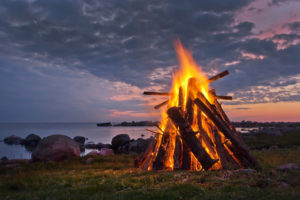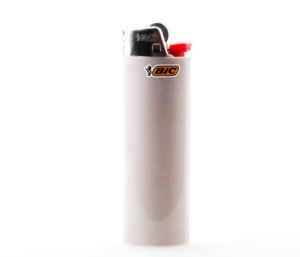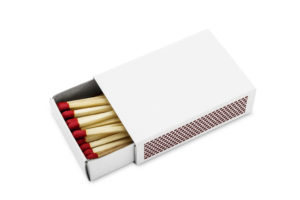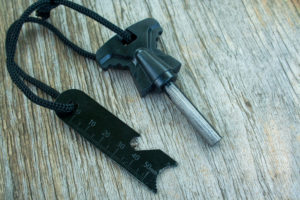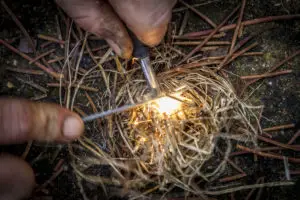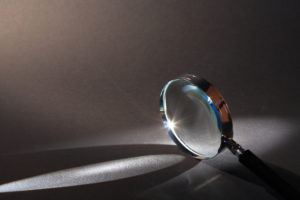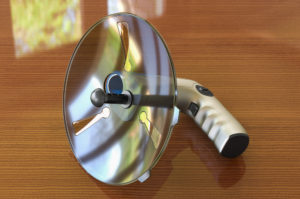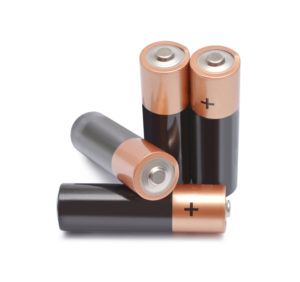Fire starting is at or near the top of all survival checklists with redundancy of method also on the list. In reality, keeping the fire alive is
SKIP AHEAD
Start With A Classic
#1 The first way to start a fire is my go-to choice, the Classic Bic lighter. It’s a full size Bic
#’s 2 through 6 – The next five fire starters are easy since they are all new Bic lighters still sealed in their store package. I prefer the Classic Bic version with as few safety features and flame controls as possible. When its dark, cold and wet, you don’t want to your numb fingers to have to fight extraneous buttons, levers or safety features designed to make it more difficult to use. Bic Classics are the Glocks of lighters, and buying Bics in bulk ensures you will have plenty on hand. Further, I suspect that as barter items, Bic lighters will rank up there with bullets and coffee.
#’s 7 and 8 – The seventh and eighth way to start a fire are matches. Like the lighters, I have a go-to match case that I use often and resupply when needed. It contains UCO-brand Stormproof matches, and extra striker strips and some fire tinder. The second match case, Exotac MATCHAP Waterproof Match Case, Gunmetal, is also packed with hurricane matches, strikers and tinder, but in a more durable (and expensive) metal tube. Stormproof matches are not cheap, but if they are needed, their added cost over basic stick matches is a ridiculous thing to worry about
#’s 9 and 10 – The next two ways to start a fire are both ferrocerium rods. Number nine is the larger sized Light My Fire Original Swedish FireSteel Army 12,000 Strike Fire Starter -... . Its quarter-inch diameter provides plenty of strength for when a large knife like the Swedish Fallkniven A1 is used to aggressively scrape the firerod. You can use the included striker, but if your hands are cold, numb, small, or injured, go for a larger striker. But don’t forget that the attached striker includes a mediocre whistle which could come in handy. Do note, however, that its not unusual for thinner firerods to snap under nervous use. This particular Firesteel is my go-to firerod and like the Bics and UCO matches. I have half a dozen of them scattered about.
Number Ten
Number ten is also a firerod, but a much smaller one. It is an Exotac nanoSTRIKER. Not cheap, but wonderfully overbuilt for it’s size. It
A Little Help
Let’s pause for moment to consider the humble fire tinder. All ignition sources do the same thing; they stimulate the ignition of something else into a self-sustaining oxidative state as long as fuel and oxygen are present. And that something else is critical especially when under the thumb of speed and limited resources. While some folks manufacture their own tinder from pinetree pitch, dryer lint, and/or ping pong balls, I prefer some of the commercial options.
My two favorites are Wetfire and Tinder-Quik. Wetfire tablets are more durable and work when damp or even floating in water, but they
#11 – Number 11 is a magnifying glass. This particular lens is clear glass, not acrylic or plastic, and the glass lens is 1.4 inches in diameter meaning it is plenty large for a wide range of uses. Smaller lenses have a much shorter working distance and while better for inspecting diamonds or coins, they can be tougher to control when fire starting under less than absolutely ideal conditions. Credit card-sized fresnel lenses like the Carson are half the power of the most lenses but gather much more light. They are an excellent backup choice that is super light and superduper thin so I guess you could count them as an 11b.
Don’t forget that many eyeglasses and reading glasses magnify light as well (11c), and old-school projectors and cameras have magnifying lenses buried inside them (11d). If you can find an old overhead projector, the fresnel lens is a super-lightweight but a dangerously effective magnifying lens (11e).
Number 11f and 11g are also lenses but really out there in practicality. 11f is to find a lens from a broken bottle, usually the bottom. Of course that means there is a bottle handy, and enough sun to punch through poor quality and often tinted glass. And 11g is the forming of a convex lens out of ice. Good luck on that one because if frozen water is handy, likely the sun is low in the sky significantly reducing the quantity of energy per unit area that can be concentrated into a flame-lighting spot. And that assumes that it’s still a sunny day and not the evening when fire starting moves to Threat Level Red.
A potential 11h is that it is theoretically possible to make a water lens using a transparent balloon or condom full of water. But maintaining the proper convex shape by squeezing a portion of the rubber sack of water, let alone holding it at the exact distance and angle from the combustible material presents an almost overwhelming number of challenges so a water lens is more a novelty than a truly useful option. But keep it in the back of your mind, you know, just in case.
#12 – Number 12 is a parabolic reflector. The Solar Spark Lighter in particular works surprisingly well, and concentrates much more
12b is to fabricate your own parabolic reflector out of a beercan bottom. Using a polishing compound like toothpaste, chocolate or car polish, you can turn the base of the can into a gleeming parabolic mirror, but like the ice lens, save it for when there is no other option or you’re bored silly.
#13 – Number 13 is the oft mentioned but rarely used steel wool and battery. By shorting out
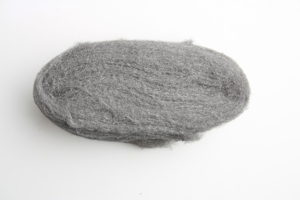
steel wool roll in color background
the battery with the steel wool, the fine strands of metal thread light up like a light bulb filament glowing red and flaming as the iron literally catches fire and burns at almost 2000 degrees F. While this method is interesting, I find it impractical since I would much rather carry deliberate survival staples rather than steel wool and an unassigned battery. Cell phone batteries are plenty powerful to insult the steel wool, but can be ruined since many have more complex internal smart-charging circuitry compared to bulk batteries of which you will need at least three volts, with the traditional nine volt battery preferred to get the attention of the steel wool fibers. Don’t forget the car batteries since 12 volts and 700 cold cranking amps will incinerate even the most stubborn and damp steel wool. But beware, if you drop a layer of steel wool across the car battery posts, your problem won’t be starting the fire but controlling it.
A 13b is to substitute metal chewing gum wrappers for steel wool. But given that so few gum brands still use a conductive aluminium wrapper for their product, steel wool is easier to procure.
#14 – Fire starting method number 14 is mixing potassium permanganate and glycerin. But watch out on this one as it burns extremely hot and bright, and ignites only when its good and ready. For best results, the potassium permanganate should be ground into a finer powder than how it is often sold. A teaspoon of KMnO4 will be plenty, and a tablespoon is more than enough to burn though most tables. Make a depression or crater in the pile of potassium permanganate and overfill it with glycerin. The reaction time is dependent on more than just particle size. The quality, freshness of the chemicals, and temperature of the glycerin play a major role. Cold glycerin reacts much, much slower than when warm. Overall, I’ve found the reaction kicks into high gear in between 20 seconds and three minutes depending on the temperature of the the glycerin, the particle size of the KMnO4 and the freshness of both. No matter what, the combustion is not immediately explosive, but you need to be able to move several feet away for safety and don’t stare into the fire- it’s that bright! Also remember that a chemical fire can light up inside your pack if the two reagents happen to hook up somehow while your back is turned.
Another option, 14b if you will, is the near explosive reaction of chlorine and brake fluid. Like the potassium permanganate/glycerin reaction, brake fluid is glycol-based. However chlorine, being a smaller and much more reactive atom, combusts with more anger and recklessness. Chlorine can be acquired from swimming pool and hot tub supply stores, but like the potassium permanganate, it should be carefully ground down to about the consistency of sugar or even finer for quick and predictable results.
There are other common chemicals that combust when mixed, but many of them border on bomb-making materials and are well beyond the scope of this article.
#15 – Number 15 is all of the ways to use wood. Fire drills, bows, etc. Fun for the whole family.
Household Accelerants
Fire tinder is great for priming larger fuels, but even tinders can use some help. Accelerants aid in the fire ignition process giving your
Magnesium fire starters that are just a block of Mg with a firerod glued to the side are a staple in survival kits. The magnesium scrapings are an accelerant, and a good one at that flaming to over 5600 degrees! But the store-bought fire starter is not the only source of magnesium. Many expensive car rims are made of the stuff although not as pure.
A few of the common garage accelerants include lubricants, paints, auto fluids including gas, oil, fuel additives, choke cleaner, starting fluid (of course), cleaning solvents, and some garden chemicals. Take a moment and read the warnings. Flammable may be good thing. In your shop, look for flammable adhesives and epoxies as well as many stains, varnishes, and paint thinners. And don’t forget the gun cleaners and oils with low flashpoints. Oh yea, and gunpowder.
The bathroom often contains some effective accelerants including hair spray, fingernail polish remover (acetone), isopropyl alcohol, spray sunscreen and bug repellant, shaving cream, hair mousse, hand sanitizer, and ethanol-rich medications. Fire tools in the kitchen include powdered non-dairy creamer, cooking oils, disinfectant sprays, and distilled spirits. And while not technically accelerants, some effective tinders include potato chips, peanuts, and oily croutons.
Your Turn
There is nothing magic about knowing 15 ways to start a fire (or even 30) and with combined effort this list will grow longer. Some notable absences from the list include the fire piston, flint and steel, and attracting lightning. Since there is always room for improvement in our preparation please add your fire starters, tinders, accelerants, and experiences in the comments section. Thanks!


